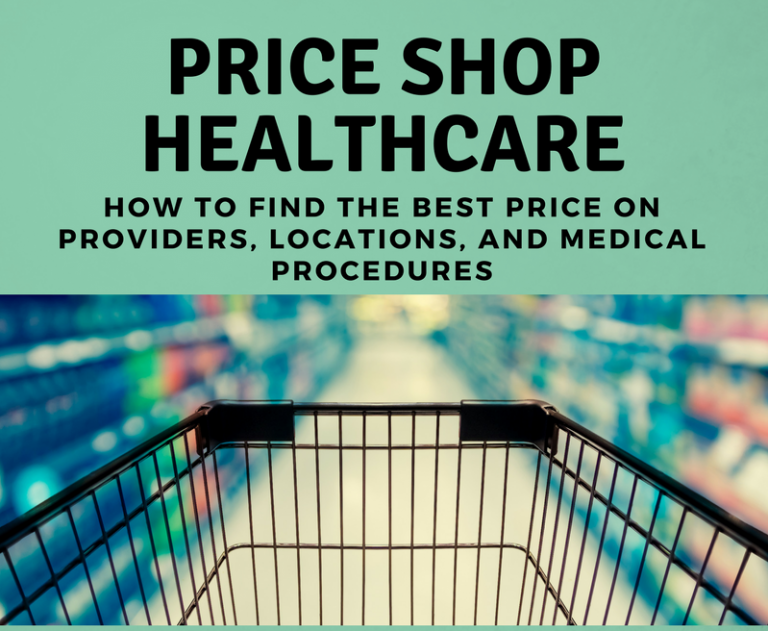
by admin | Mar 28, 2018 | Benefit Management, Benefit Plan Tips, Tricks and Traps, Human Resources
 As the costs of health care soar, many consumers are looking for ways to control their medical spending. Also, with the rise of enrollment in high deductible health plans, consumers are paying for more health care out-of-pocket. From medical savings accounts to discount plans for prescriptions, patients are growing increasingly conscious of prices for their healthcare needs. Price shopping procedures and providers allows you to compare prices so that you are getting the best value for your care.
As the costs of health care soar, many consumers are looking for ways to control their medical spending. Also, with the rise of enrollment in high deductible health plans, consumers are paying for more health care out-of-pocket. From medical savings accounts to discount plans for prescriptions, patients are growing increasingly conscious of prices for their healthcare needs. Price shopping procedures and providers allows you to compare prices so that you are getting the best value for your care.
Why do you need to look beyond your nearby and familiar providers and locations for healthcare? Here’s a hypothetical example: Chris is a 45-year old male in good physical health. During his last check-up he mentions to his doctor that he’s had some recent shortness of breath and has been more tired as of late. His doctor orders an EKG to rule out any problems. If Chris went to his local hospital for this procedure, it would cost $1150. He instead looks online and shops around to find other providers in his area and finds he can get the same procedure for $450 at a nearby imaging center. His potential savings is $700 simply by researching locations.
So where do you start when shopping around for your health care? A good place to begin is by researching your health plan online. Insurance companies will post cost estimates based on facility, physician, and type of procedure. Keep in mind that these are just estimates and may vary based on what coverage you are enrolled in. Another way to shop is by checking out websites that have compiled thousands of claims information for various procedures and locations to give an estimate of costs. However, deciphering whether a site is reporting estimates based on the “medical sticker price” of charges or rates for private insurance plans or Medicare is difficult. There are huge differences in prices at different providers for the exact same procedure. This is because contracts between insurance agencies and providers vary based on negotiated amounts. This makes it hard to get consistent pricing information.
Check out these sites that do a great job comparing apples to apples for providers:
- Healthcare Blue Book
- What Kelly Blue Book is to cars, Healthcare Blue Book is to medical pricing
- New Choice Health
- Reports on pricing of medical procedures, providers, quality of facilities, and customer feedback for healthcare in all 50 states
- The Leapfrog Group
- Publishes data on hospitals so patients can compare facilities and costs for treatments and procedures
After compiling all the information on prices and procedures, you can still call and negotiate costs with the location of your care. Fair Health Consumer has tips on how to negotiate with providers and plan for your healthcare needs.
Knowledge is POWER and when you spend time researching and comparing healthcare costs, you are empowering yourself! Exercising due diligence to plan for you and your family’s medical needs will save you money and give you confidence in your decisions for care.

by admin | Mar 23, 2018 | Employee Benefits, Human Resources
 Fear of missing out—is more than just a hashtag. Many Millennials admit that #FOMO drives a lot of their decisions on what they wear, what they do, even what they eat and drink. We live in a world of social influence.
Fear of missing out—is more than just a hashtag. Many Millennials admit that #FOMO drives a lot of their decisions on what they wear, what they do, even what they eat and drink. We live in a world of social influence.
But one area where #FOMO really does you a disservice? No one is afraid of missing out on the benefits of life insurance. And why should you? There are so many other things competing for your dollars. That said, do you know what you’re missing out on by not having it? Are you making one or more of these mistakes?
You think life insurance is much more expensive than it actually is. Three in four Millennials overestimate the cost of life insurance—sometimes by a factor of 2, 3, or even more! (2017 Insurance Barometer Study by Life Happens and LIMRA) Imagine being able to afford life insurance for the cost of that daily latte, and for less money than your avocado toast habit!
You think you can’t qualify for life insurance. Nothing could be further from the truth, and yet four in 10 Millennials think this is true, according to the same study! Younger candidates have an easier time getting life insurance because they are generally healthier.
You’ll turn to GoFundMe if something goes wrong. In an era where social networking does all things, it’s natural to think that your loved ones can crowdfund their way to solvency after something happens. But life insurance benefits aren’t taxed like GoFundMe proceeds are, and life insurance has a defined, immediate payout that GoFundMe does not. Plus, your loved ones don’t need the stress or the stigma of having to ask others for help.
You’d rather spend that money on other things. In fact, one study recently suggested that many Millennials are more concerned about planning their next night out with a significant other than planning for their financial future. But sensible steps now will make for a better future with that significant other long past tomorrow night’s date.
You don’t care because you don’t have people depending on you for money. Take a look at your student loans. Were any of them private loans? Who is liable for them—in full, often immediately—if something happens to you? There are other debts you may need to consider as well—anything where you have a co-signer.
You keep saying you’ll get around to buying insurance, but don’t. Millennials are getting married, having families! Young families have enough to worry about with daycare costs and increased medical costs, right? Well, imagine what your young family would do about those bills if something happened to you. Could your spouse pay the rent or mortgage without your income?
You tune out when “adulting” gets too hard. One recent college grad recently confessed to me that he hadn’t elected into any of his employee benefits at the dream job he got in his field because “my dad takes care of that.” He was shocked to learn what he was missing out on!
Yes, adulting *is* hard, but a sound financial plan that includes retirement and insurance coverage (health, life, and disability insurance are all part of that plan) goes a long way to making sure that you don’t look back on your younger years and think, “Oh, why didn’t I start this sooner?” Plus, you don’t have to do it alone—that’s what insurance agents are for. They will sit down with you at no cost, or obligation, to discuss what you need and how to get coverage to fit your budget. But then, signing up—that IS on you. Don’t miss out.
By Helen Mosher
Originally published by www.LifeHappens.org

by admin | Mar 21, 2018 | IRS, Retirement
 In its March 15, 2018, decision, the U.S. Court of Appeals for the Fifth Circuit overturned the U.S. Department of Labor’s (DOL) Fiduciary Rule that expanded the definition of an investment advice fiduciary under the federal Employee Retirement Income Security Act (ERISA). Under the Fiduciary Rule, investment brokers were going to be required to put the interest of their clients before their own when advising about individual retirement accounts (IRA) and 401(k) plans. Read our blog post on the rule from April 11, 2016.
In its March 15, 2018, decision, the U.S. Court of Appeals for the Fifth Circuit overturned the U.S. Department of Labor’s (DOL) Fiduciary Rule that expanded the definition of an investment advice fiduciary under the federal Employee Retirement Income Security Act (ERISA). Under the Fiduciary Rule, investment brokers were going to be required to put the interest of their clients before their own when advising about individual retirement accounts (IRA) and 401(k) plans. Read our blog post on the rule from April 11, 2016.
According to the Fifth Circuit’s decision, “[t]he Fiduciary Rule … bears hallmarks of ‘unreasonableness’ … and arbitrary and capricious exercises of administrative power.” In other words, the court found that the DOL exceeded its authority with the Fiduciary Rule. Additionally, through its ruling, the court agreed with the plaintiffs’ claims that “the Rule is inconsistent with the governing statutes, the DOL overreached to regulate services and providers beyond its authority, the DOL’s imposed legally unauthorized contract terms to enforce the new regulations, the Rule violates the First Amendment, and it is arbitrary and capricious in the treatment of variable and fixed indexed annuities.”
For the time being, the Fiduciary Rule has been overturned, but the issue may be pursued in the U.S. Supreme Court, which has the authority to overturn the Fifth Circuit’s decision.
Originally Published ThinkHR.com

by admin | Mar 14, 2018 | ACA, HSA/HRA, IRS

Taking control of health care expenses is on the top of most people’s to-do list for 2018. The average premium increase for 2018 is 18% for Affordable Care Act (ACA) plans. So, how do you save money on health care when the costs seems to keep increasing faster than wage increases? One way is through medical savings accounts.
Medical savings accounts are used in conjunction with High Deductible Health Plans (HDHP) and allow savers to use their pre-tax dollars to pay for qualified health care expenses. There are three major types of medical savings accounts as defined by the IRS. The Health Savings Account (HSA) is funded through an employer and is usually part of a salary reduction agreement. The employer establishes this account and contributes toward it through payroll deductions. The employee uses the balance to pay for qualified health care costs. Money in HSA is not forfeited at the end of the year if the employee does not use it. The Health Flexible Savings Account (FSA) can be funded by the employer, employee, or any other contributor. These pre-tax dollars are not part of a salary reduction plan and can be used for approved health care expenses. Money in this account can be rolled over by one of two ways: 1) balance used in first 2.5 months of new year or 2) up to $500 rolled over to new year. The third type of savings account is the Health Reimbursement Arrangement (HRA). This account may only be contributed to by the employer and is not included in the employee’s income. The employee then uses these contributions to pay for qualified medical expenses and the unused funds can be rolled over year to year.
There are many benefits to participating in a medical savings account. One major benefit is the control it gives to employee when paying for health care. As we move to a more consumer driven health plan arrangement, the individual can make informed choices on their medical expenses. They can “shop around” to get better pricing on everything from MRIs to prescription drugs. By placing the control of the funds back in the employee’s hands, the employer also sees a cost savings. Reduction in premiums as well as administrative costs are attractive to employers as they look to set up these accounts for their workforce. The ability to set aside funds pre-tax is advantageous to the savings savvy individual. The interest earned on these accounts is also tax-free.
The federal government made adjustments to contribution limits for medical savings accounts for 2018. For an individual purchasing single medical coverage, the yearly limit increased $50 from 2017 to a new total $3450. Family contribution limits also increased to $6850 for this year. Those over the age of 55 with single medical plans are now allowed to contribute $4450 and for families with the insurance provider over 55 the new limit is $7900.
Health care consumers can find ways to save money even as the cost of medical care increases. Contributing to health savings accounts benefits both the employee as well as the employer with cost savings on premiums and better informed choices on where to spend those medical dollars. The savings gained on these accounts even end up rewarding the consumer for making healthier lifestyle choices with lower out-of-pocket expenses for medical care. That’s a win-win for the healthy consumer!

by admin | Mar 9, 2018 | HSA/HRA, IRS
 On March 5, 2018, the Internal Revenue Service (IRS) announced a reduction in the maximum annual contribution allowed for Health Savings Accounts (HSAs) in 2018. The change does not affect people whose HSA contributions are based on self-only health coverage, but it does affect those with family coverage under a qualifying High Deductible Health Plan (HDHP). Previously, the 2018 HSA contribution limit for persons with family HDHP coverage was $6,900. That limit is now reduced retroactively to $6,850.
On March 5, 2018, the Internal Revenue Service (IRS) announced a reduction in the maximum annual contribution allowed for Health Savings Accounts (HSAs) in 2018. The change does not affect people whose HSA contributions are based on self-only health coverage, but it does affect those with family coverage under a qualifying High Deductible Health Plan (HDHP). Previously, the 2018 HSA contribution limit for persons with family HDHP coverage was $6,900. That limit is now reduced retroactively to $6,850.
In Revenue Bulletin 2018-10, the IRS explains that the recently-enacted tax reform law requires recalculating inflation-adjusted amounts under various tax code provisions. One of the affected provisions is § 223 pertaining to HSAs. Using the new required method of applying annual inflation adjustments, the 2018 HSA contribution limit for those with family HDHP coverage is $6,850, which is a $50 reduction from the amount previously announced.
HSA Summary
An HSA is a tax-exempt savings account employees can use to pay for qualified health expenses. To be eligible to contribute to an HSA, an employee:
- Must be covered by a qualified high deductible health plan (HDHP);
- Must not have any disqualifying health coverage (called “impermissible non-HDHP coverage”);
- Must not be enrolled in Medicare; and
- May not be claimed as a dependent on someone else’s tax return.
HSA 2018 Limits
Limits apply to HSAs based on whether an individual has self-only or family coverage under the qualifying HDHP.
2018 HSA contribution limit:
- Single: $3,450
- Family: $6,850
- Catch-up contributions for those age 55 and older remains at $1,000
2018 HDHP minimum deductible (not applicable to preventive services):
- Single: $1,350
- Family: $2,700
2018 HDHP maximum out-of-pocket limit:
- Single: $6,650
- Family: $13,300*
*If the HDHP is a nongrandfathered plan, a per-person limit of $7,350 also will apply due to the ACA’s cost-sharing provision for essential health benefits.
Originally Published By ThinkHR.com

 As the costs of health care soar, many consumers are looking for ways to control their medical spending. Also, with the rise of enrollment in high deductible health plans, consumers are paying for more health care out-of-pocket. From medical savings accounts to discount plans for prescriptions, patients are growing increasingly conscious of prices for their healthcare needs. Price shopping procedures and providers allows you to compare prices so that you are getting the best value for your care.
As the costs of health care soar, many consumers are looking for ways to control their medical spending. Also, with the rise of enrollment in high deductible health plans, consumers are paying for more health care out-of-pocket. From medical savings accounts to discount plans for prescriptions, patients are growing increasingly conscious of prices for their healthcare needs. Price shopping procedures and providers allows you to compare prices so that you are getting the best value for your care.



